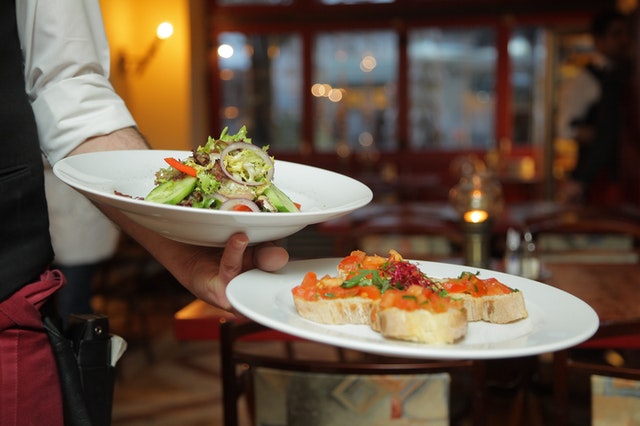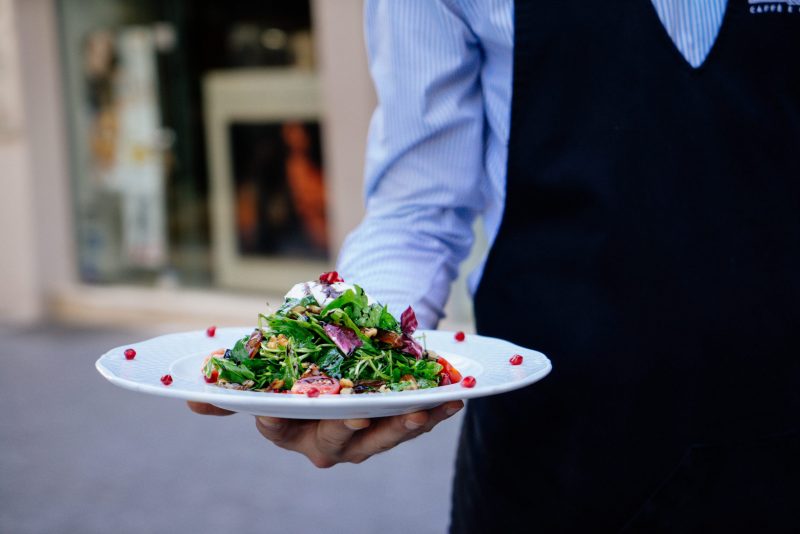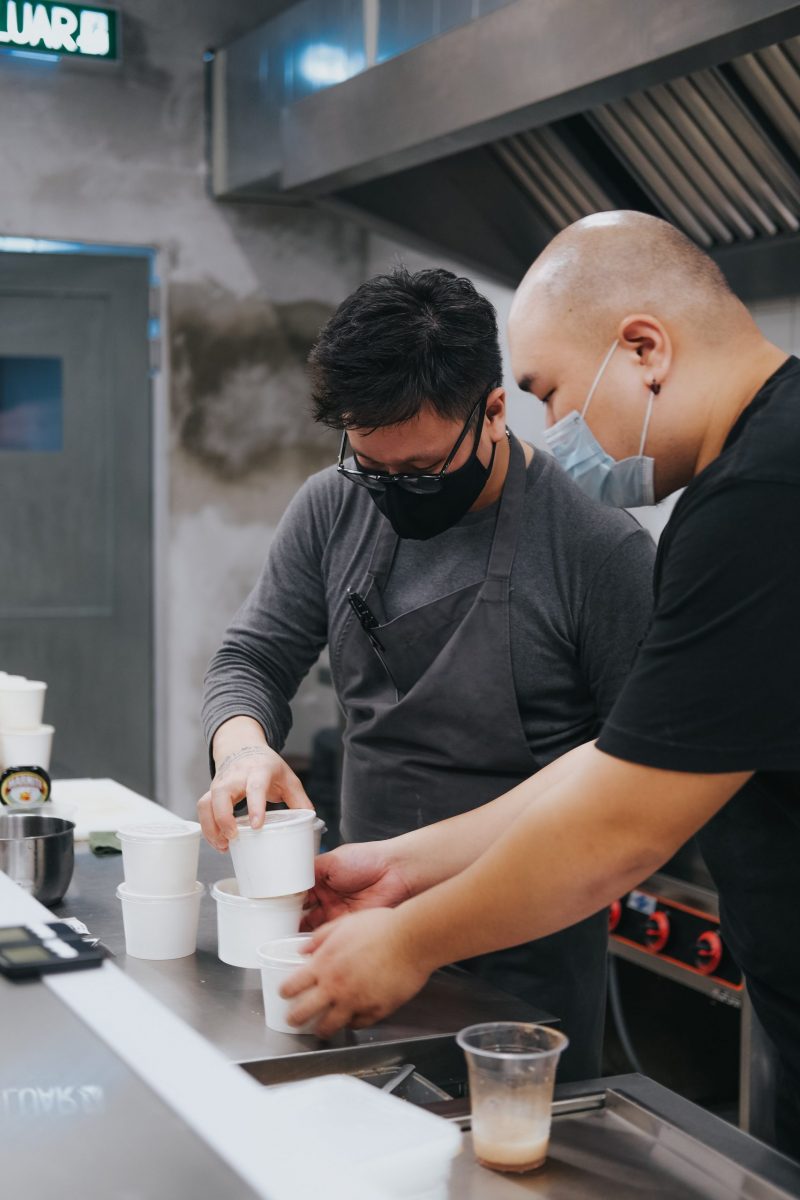Our free ServSafe practice tests will help you prepare for your ServSafe examinations. The National Restaurant Association created and runs the ServSafe Food Safety Training Program to help teach the food service industry about all areas of food safety.
ServSafe Food Handler, ServSafe Manager, ServSafe Alcohol, and ServSafe Allergens are among the training/certification courses included in the program.
In this article, ServSafe-Prep will provide you with the fullest Servsafe Food Handler Study Guide which will definitely help you well prepare for your examination.
General Information
The ServSafe Food Handler Test is intended to test employees’ food safety understanding in a food service setting. It assesses the fundamental knowledge required of non-management food workers.
There are 40 questions in the test, and it is not timed. You must pass with a score of 75% or higher to receive your food handler certification. This means you must properly answer 30 of the 40 questions.
The topics covered on this test are listed in the next paragraphs, along with the information you’ll need to study and know about them. Practice Questions for the ServSafe Food Handler Test relating to food-handling abilities are a great way to enhance your examination of this study guide. Check out our website for Practice Questions.

>>> Read More: ServSafe Manager Study Guide.
Basic Food Safety
Foods can become unsafe in a variety of ways, resulting in contamination that can lead to foodborne illness, which has a negative impact on food service establishments. It is the responsibility of food handlers to keep consumers safe by knowing and detecting potential contamination sources.
Personal Hygiene
Understanding proper fingernail length, glove use, and what should and should not be worn at work, as well as proper hand washing processes, where to eat and drink while at work, and when to report signs of sickness to your supervisor, are all part of good hygiene.
Procedure for Handwashing
The simplest approach to keep foods and surfaces free of contamination is to wash your hands for 20 seconds. Food handlers are required to:
- Hands and arms should be washed under hot running water (as hot as can be tolerated)
- To get a rich lather, use enough soap
- For 10 to 15 seconds, lather hands and arms, between fingers, and under fingernails. It is advised that you wash your hands within at least 20 seconds.
- Hands and arms should be thoroughly rinsed under hot running water
- Hands and arms should be dried with a paper towel or hand dryer, not on an apron, uniform, or clothes.
Then, to avoid contaminating hands on the way back to work, use a paper towel to turn off the faucet and open the bathroom door.
When Should You Wash Your Hands?
Hands should be washed before going to work, after using the restroom, and after doing any of the following:
- Putting your hands in your hair, face, body, clothes, or aprons
- When handling raw meat, poultry, or seafood, wash your hands before and after
- Trash pickup
- Sneezing, coughing, or the use of a tissue
- Using chemical substances
- Tobacco use, chewing gum, or smoking
- Cleaning up dirty tables
- Consumption of food or beverage
- Getting your hands on money
- Entering or exiting the kitchen
- Touching service animals or aquatic animals from a tank, such as lobsters
- Touching soiled equipment, work surfaces, clothing, or anything else that might contaminate hands is prohibited.
Before starting a new activity or putting on gloves, always wash your hands.
Cleaning supplies and products for hands
Additional procedures, such as hand sanitizers, may be used in some establishments to ensure infections are not transferred from food handlers to diners.
- Sanitizers for the hands: Hand sanitizer should never be used instead of washing your hands. After handwashing, only apply hand sanitizer. Always use the sanitizer according to the manufacturer’s instructions.
- Sink Supplies for Handwashing; Handwashing should be done at a different sink with hot and cold running water, soap, single-use paper towels or a hand dryer, and a trash can. If any of these are missing, notify your manager.
Where should you wash your hands?
Handwashing sinks in food service establishments must be marked, have properly supplied supplies, and be utilized according to correct practice.
- Never be washed in sinks that are being used for other tasks
- Never be used to dump used water, prep food, fill containers or wash dishes
- Should be accessible, with no food, equipment, or cooking supplies blocking them.
Other hand concerns
Beyond handwashing, safe food handlers must also know how to utilize gloves appropriately and keep their hands and fingernails clean.
- Putting on Gloves: Gloves should never be used as a replacement for appropriate handwashing. With bare hands, never handle ready-to-eat meals (items that can be consumed without extra preparation, washing, or cooking). It’s possible that you’ll spread germs and contaminate the food.
- Hand Hygiene: Hands and fingernails should be kept clean and properly maintained by food handlers.
- Fingernail care: Fingernail care consists of keeping your nails short, filed, and clean. Long, ragged nails are difficult to clean and may harbor pathogens.
- False fingernails and nail polish: Never use artificial nails, which are difficult to keep clean and might fall off, contaminating your body.
- Wounds on hands: Pathogens can be found in wounds. A tight bandage or finger cot, as well as a disposable glove, should be used to cover hand or wrist wounds. To avoid leaking, completely cover arm wounds with a tight, clean bandage. Cover bodily wounds with a bandage that is dry, sturdy, and fits snugly.
Putting on appropriate clothes
To present a pleasant and professional image, good hygiene involves wearing clean clothes to work and bathing regularly. Pathogens that can cause foodborne disease can be found on dirty skin, hair, and clothes. Hair must be covered, clean clothing must be worn, aprons must be worn, and jewelry must not be worn by food handlers.
Additional safe practices
Good hygiene includes more than just wearing clean clothes and cleaning your hands; it also helps keep you and everyone you work with safe, which keeps clients safe. To avoid risks, eating and drinking procedures have been established.
- Tobacco Use, Eating, and Drinking; Because viruses live in your saliva, there are rules and specific places for eating, drinking, chewing gum, and smoking. In service areas, food preparation areas, and dishwashing areas, never eat, drink, chew gum, or use cigarettes.
- Illness: When you’re ill at work, you run the risk of spreading pathogens to your coworkers, clients, food, and/or equipment. If you have vomiting, diarrhea, jaundice (yellow eyes or skin), or a sore throat with a fever, notify your manager. It’s possible that you’re suffering from a foodborne illness.
Time and Temperature
Food handlers must be aware of the relevance of time and temperature, as well as how they may either assist or prevent disease growth. Hot meals must be kept hot, while cold items must be kept cold. TCS foods are those that require time and temperature control for safety.
The importance of temperature and time
When kept at the incorrect temperature for too long, TCS foods are more prone to bacterial development. TCS goods deteriorate more rapidly and allow for hazardous amounts of disease development if not stored at the proper temperature. Foodborne diseases might occur if dangerous pathogens are present.
- The Danger Zone for Food at High Temperatures: TCS foods must be stored at the appropriate temperature and out of what is known as the temperature danger zone to stay safe. The temperature danger zone is defined as the range between 41°F and 135°F (5°C and 57°C) in which diseases grow exponentially. Foods containing TCS must be stored below 41°F or over 135°F. If you check a food’s temperature and it’s in the danger zone, you may need to cook it longer, reheat it, or toss it away to keep it safe.
- Food Temperature Measurement: To ensure that meals are at the proper temperature, proper usage of a food thermometer is required. Food thermometers are used to ensure that cold food is kept cold enough throughout delivery and storage, as well as to ensure that hot food is kept hot enough during preparation and before serving.
Getting food
The food handler keeps track of time and temperature from the moment the food is delivered until it is stored, thawed, prepared, cooked, and served. The temperature must be kept at all times. Check for the correct temperature, undamaged packing, and acceptable quality when receiving food. Poor quality might suggest that the food was stored at an incorrect temperature.
- Food that is served cold: TCS meals should be served cold, at 41° F or lower, and according to the manufacturer’s recommendations.
- Food that has been frozen: Frozen meals should be delivered solidly frozen. Fluids, water stains, or ice crystals on food goods or packaging should be rejected. The presence of large ice crystals on frozen goods or packaging indicates that something has been thawed and refrozen.
- Food that is hot: Hot meals should be served at 135 degrees Fahrenheit or above.
- Other Arguments Against Food Delivery: Foods that have passed their expiry or use-by dates, have an odd color or mold, or have an off odor should be discarded. Slimy, sticky, or dry meat, fish, or fowl should also be rejected by food handlers.
Food storage
Food is placed in storage once it is received, and it may be moved in and out of storage. When preserving food, time and temperature are critical and must be closely controlled. The received-on and use-by dates on stored foods should be clearly labeled. Food that is transported off-site must be tagged and kept at a specific temperature. This also applies to packaged items for self-service. Safe food storage, labeling, and holding are all guided by principles.
Food thawing and preparation
Foods that have been removed from storage to be thawed and prepared must be closely monitored. When frozen foods or TCS foods must be thawed, they are removed from temperature-controlled storage and put in the temperature risk zone, where they must be closely monitored to ensure pathogen development is under control.
- Thawing: Foods should never be allowed to thaw at room temperature. The temperature of thawing frozen meals must be controlled. Foods that are thawing under running water must be kept at a constant temperature of 41° F for no more than four hours.
- During Preparation: Foods must also be monitored while they are being prepared. When TCS foods are prepared, they are immediately exposed to hazardous temperatures, and they should not be left out for lengthy periods of time. To avoid ingredients spending too long in the temperature risk zone, never make TCS dishes in big batches. As quickly as feasible, return all TCS items to the cooler.
Food preparation and beyond
Following thawing and preparation, meals are cooked, held, cooled, and sometimes reheated. Using the right thermometer and reducing the time foods spend in the temperature risk zone, time and temperature must be monitored at these stages. Cooking, storing, chilling, and reheating meals all have their own set of rules.
- Internal Food Temperatures (Cooking): To minimize pathogens that may be present, foods must be cooked to proper internal temperatures for the appropriate period of time.
- Populations in Risk: Due to weakened immune systems, certain persons are more susceptible to foodborne diseases. The elderly, preschool-aged children, and anybody with a weakened immune system as a result of sickness are among them.
- Using a Microwave Oven: Microwave Cooked Meat, Seafood, Poultry, and Eggs Must Reach 165° F and should be covered to prevent drying and turned halfway during cooking to guarantee equal cooking.
- Holding Food: TCS foods should be held on food-grade equipment and should be time and temperature regulated during hot and cold holding. Hot foods must be kept at 135 degrees F or above, while cold foods must be kept at 41 degrees F or below.
- Cooling Food: Never put a large container of hot food in the refrigerator, and never let food cool to room temperature. Foods must cool from 135 ℉ to 70 ° F in two hours, then to 41 ℉ or below in the next four hours. To control pathogen growth, foods that do not cool to 70° F in two hours must be reheated and chilled again.
- Food Reheating: Reheating temps for several TCS foods are specified. Soups, for example, must reach 165° F for 15 seconds in two hours. When reheating foods, never use hot-holding equipment.
Cross-Contamination
When germs are passed and spread from one person, object, food, or surface to another, cross-contamination occurs, which can result in foodborne disease. Reject any food or non-food products that are open, ripped, water damaged, leaky, discolored, stinky, rusted, dented, swollen, or otherwise damaged. These might indicate contamination and could cross-contaminate your establishment.
Preventing cross-contamination
When keeping goods, keep them in appropriate locations and wrap them tightly to avoid something from slipping into them. Use only food-grade containers to keep food instead of chemical ones. Separately store and transport raw and ready-to-eat meals.
- During the food preparation Process: If you’re not paying attention, it’s simple to cross-contaminate raw and ready-to-eat meals at the same time. However, if you cross-contaminate, you risk making customers or coworkers sick. When it comes to food preparation, there are some rules to follow.
- Safe Practices with Tools and Surfaces
- Safe Practices with Produce
- Safety in Self-Service: Customers reaching beneath the sneeze guard, getting food with their bare hands, or reusing dirty dishes can contaminate self-service facilities like buffets. Buffets are prone to biological, chemical, and physical contamination, but self-service standards can help keep them safe.
- Safety When Serving Food: When serving clients, servers risk cross-contamination by touching food-contact surfaces. The inner rim of a plate or the rim of drinking glass is a food-contact surface. When it comes to touching utensils, handles, and other items that servers handle, you must comply with the rules in your establishment.
- Storage Security: To avoid cross-contamination, it’s also crucial to maintain non-food objects clean and free of germs. All equipment, utensils, food prep surfaces, and cleaning materials must be properly stored.
- What Happens If There Is Cross-Contamination?: If cross-contamination occurs, do everything you can to eliminate the problem. To avoid future usage, set aside the contaminated goods. If you’re unsure what to do, consult your boss, but act quickly to avoid further contamination.
Allergens
Some clients are allergic to particular foods, and coming into touch with them might result in serious illness or even death. Cross-contact occurs when allergens come into touch with foods or surfaces, and it can be harmful to allergy sufferers. Cross-contact must be avoided when preparing for and serving allergy-prone consumers.
- Allergens that are commonly encountered: There are a variety of foods that contain allergens (proteins that cause allergic responses), but the following eight are the most common: Milk, eggs, soy, fish, tree nuts, peanuts, wheat, and crustacean shellfish.
- Serving Food in a Safe Way: To avoid cross-contact while serving customers with food allergies, take the following precautions:
- Tell the client how each menu item is cooked, and if you’re not sure, contact your manager
- All “hidden” ingredients must be revealed.
- Suggestions for menu items that are free of food allergies are welcome.
- Any allergy-specific order should be clearly communicated to the kitchen.
- Separately, hand-deliver the special order.
- Safe Food Preparation: During preparation and cooking, cross-contact must be avoided.
- Look for allergies on ingredient labels and in recipes.
- Everything you’ll need to make the food, including the table, should be washed, rinsed, and sanitized. Separate utensils for allergy orders may be required by your establishment.
- Put on new gloves after washing your hands. Cross-contact with other meals, drinks, gloves, equipment, utensils, and so on is not recommended.
- For frying meals, several separate fryers and cooking oils should be utilized.
- If There Is Any Cross-Contact: Keep everything that has come into contact with a food allergy away from the consumer. Never provide cross-contact meals to a consumer who is allergic. Remove them from the equation. If you believe cross-contact has occurred, notify your manager.
If You Have An Allergic Reaction: Call your local emergency number and tell your manager if a consumer has an allergic reaction. To safeguard the customer, you must take action.
Cleaning and Sanitizing
To assist prevent foodborne disease, food service establishments must be cleaned and sanitized, and these methods are not the same. Cleaning is the process of removing food and/or dirt from a surface. Sanitizing reduces the spread of diseases and the appearance of common pests such as bugs and vermin.
Sanitizing vs. Cleaning
Varying surfaces and objects need different levels of protection. Some just require cleaning. Others will need to be cleaned and sanitized to guarantee germs are no longer present. Because utensils and equipment are kept in the risk zone, any germs left behind have the potential to multiply quickly.
Cleaning Dishes
Dishes are washed in a dish machine or a three-compartment sink in food service establishments. Dishwashers are used to clean plates, bowls, cups, glasses, and flatware. The three-compartment sink is used to clean larger objects like pots, pans, and buffet table pans. When utilizing either, there are certain processes to follow to ensure that the objects are thoroughly cleaned and sanitized.
Garbage Management
After handling garbage, food handlers are susceptible to cross-contamination. Garbage may contribute to smells and pests, therefore it should be removed as quickly as possible while being cautious not to contaminate anything. Garbage cans near food preparation areas should never be cleaned. Both the inside and outside of the cans should be cleaned. Outside receptacles should have their lids closed. When not in use, keep the lids on inside cans closed.
Pest Management
Pests can contaminate food both physically and biologically, resulting in foodborne disease. If you notice evidence of pests such as droppings, eggs, or nests, notify your manager. Check the package for tears, rips, and bite marks.
FAQs
Conclusion
In conclusion, the ServSafe food handler study guide equips individuals with vital knowledge and skills to maintain food safety standards. It emphasizes proper hygiene practices, safe food handling, and preventing foodborne illnesses. By studying and applying these principles, food handlers can ensure the well-being of consumers and contribute to a healthier and safer food service industry.
Is this Servsafe Food Handler Study Guide too long? You may find it long but it already covers all the knowledge as well as skills you may have to obtain during preparing for your important exam. We hope you follow this study guide and successfully pass your exam.
Visit our websites to get more information and free ServSafe practice test. Hope that our free ServSafe Study Guide 2021 helps you gain all the essential knowledge for your coming exam! To download, visit our website for your IOS or Android device.




